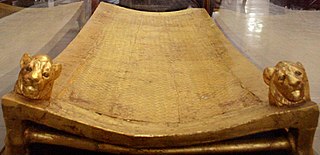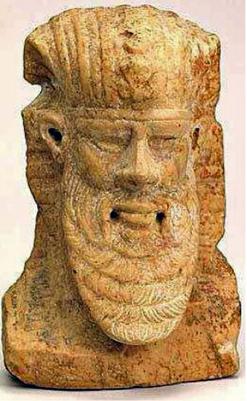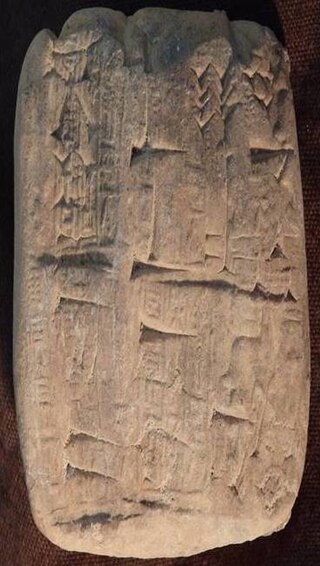
Quedlinburg is a town situated just north of the Harz mountains, in the district of Harz in the west of Saxony-Anhalt, Germany. As an influential and prosperous trading centre during the early Middle Ages, Quedlinburg became a center of influence under the Ottonian dynasty in the 10th and 11th centuries. The castle, church and old town, dating from this time of influence, were added to the UNESCO World Heritage List in 1994 because of their exceptional preservation and outstanding Romanesque architecture.

Whitewright is a town in Fannin and Grayson Counties in the U.S. state of Texas. The population was 1,604 at the 2010 census, down from 1,740 at the 2000 census.

The Iraq Museum is the national museum of Iraq, located in Baghdad. It is sometimes informally called the National Museum of Iraq, a recent phenomenon influenced by other nations' naming of their national museums; The Iraq Museum's name is inspired by the name of the British Museum, however. The Iraq Museum contains precious relics from the Mesopotamian, Abbasid and Persian civilizations. It was looted during and after the 2003 Invasion of Iraq. Despite international efforts, only some of the stolen artifacts have been returned. After being closed for many years while being refurbished, and rarely open for public viewing, the museum was officially reopened in February 2015.

Art theft, sometimes called artnapping, is the stealing of paintings, sculptures, or other forms of visual art from galleries, museums or other public and private locations. Stolen art is often resold or used by criminals as collateral to secure loans. Only a small percentage of stolen art is recovered—an estimated 10%. Many nations operate police squads to investigate art theft and illegal trade in stolen art and antiquities.

The Bowers Museum is an art museum located in Santa Ana, California. The museum's permanent collection includes more than 100,000 objects, and features notable strengths in the areas of pre-Columbian Mesoamerica, Native American art, the art of Asia, Africa, and Oceania, and California plein-air painting. The Bowers organizes and hosts special exhibitions from institutions throughout the world, and travels exhibitions nationally and internationally. The museum has a second campus two blocks south of the main site, Kidseum, a children's museum with a focus on art and archaeology. The Bowers Museum and Kidseum are located in Santa Ana 6.4 km south of Disneyland.

A treasure binding or jewelled bookbinding is a luxurious book cover using metalwork in gold or silver, jewels, or ivory, perhaps in addition to more usual bookbinding material for book-covers such as leather, velvet, or other cloth. The actual bookbinding technique is the same as for other medieval books, with the folios, normally of vellum, stitched together and bound to wooden cover boards. The metal furnishings of the treasure binding are then fixed, normally by tacks, onto these boards. Treasure bindings appear to have existed from at least Late Antiquity, though there are no surviving examples from so early, and Early Medieval examples are very rare. They were less used by the end of the Middle Ages, but a few continued to be produced in the West even up to the present day, and many more in areas where Eastern Orthodoxy predominated. The bindings were mainly used on grand illuminated manuscripts, especially gospel books designed for the altar and use in church services, rather than study in the library.

Nazi plunder was the stealing of art and other items which occurred as a result of the organized looting of European countries during the time of the Nazi Party in Germany.

Repatriation is the return of the cultural property, often referring to ancient or looted art, to their country of origin or former owners.

Treasure hunting is the physical search for treasure. For example, treasure hunters try to find sunken shipwrecks and retrieve artifacts with market value. This industry is generally fueled by the market for antiquities. The practice of treasure-hunting can be controversial, as locations such as sunken wrecks or cultural sites may be protected by national or international law concerned with property ownership, marine salvage, sovereign or state vessels, commercial diving regulations, protection of cultural heritage and trade controls.

Looted art has been a consequence of looting during war, natural disaster and riot for centuries. Looting of art, archaeology and other cultural property may be an opportunistic criminal act or may be a more organized case of unlawful or unethical pillage by the victor of a conflict. The term "looted art" reflects bias, and whether particular art has been taken legally or illegally is often the subject of conflicting laws and subjective interpretations of governments and people; use of the term "looted art" in reference to a particular art object implies that the art was taken illegally.

The Monuments, Fine Arts, and Archives Section Unit (MFAA) was a program established by the Allies in 1943 to help protect cultural property in war areas during and after World War II. The group of approximately 400 service members and civilians worked with military forces to safeguard historic and cultural monuments from war damage, and as the conflict came to a close, to find and return works of art and other items of cultural importance that had been stolen by the Nazis or hidden for safekeeping. Spurred by the Roberts Commission, MFAA branches were established within the Civil Affairs and Military Government Sections of Allied armies.

Quedlinburg Abbey was a house of secular canonesses (Frauenstift) in Quedlinburg in what is now Saxony-Anhalt, Germany. It was founded in 936 on the initiative of Saint Mathilda, the widow of the East Frankish King Henry the Fowler, as his memorial. For many centuries it and its abbesses enjoyed great prestige and influence. Quedlinburg Abbey was an Imperial Estate and one of the approximately forty self-ruling Imperial Abbeys of the Holy Roman Empire. It was disestablished in 1802/3. The church, known as Stiftskirche St Servatius, is now used by the Lutheran Evangelical Church in Germany.

Exhibitions of artifacts from the tomb of Tutankhamun have been held at museums in several countries, notably the United Kingdom, Soviet Union, United States, Canada, Japan, and France.
Art theft and looting occurred on a massive scale during World War II. It originated with the policies of the Axis countries, primarily Nazi Germany and Japan, which systematically looted occupied territories. Near the end of the war the Soviet Union, in turn, began looting reclaimed and occupied territories. "The grand scale of looted artwork by the Nazis has resulted in the loss of many pieces being scattered across the world."

Portrait of a Young Man is a painting by Raphael. It is often thought to be a self-portrait. During the Second World War the painting was stolen by the Germans from Poland. Many historians regard it as the most important painting missing since World War II.
William Holmes Honan was an American journalist and author who directed coverage of the arts at The New York Times as its culture editor in the 1980s. Honan held senior editorial positions at the New York Times Magazine, Newsweek, Saturday Review and The Villager, a weekly newspaper serving downtown Manhattan.

The 2011 Montreal Museum of Fine Arts theft took place in two separate incidents during September and October of that year. In both instances, the same thief took a small ancient stone piece that was openly exhibited, without a protective case, and smuggled it out of the museum. One has since been recovered; however, the thief remains unidentified and the whereabouts of the other is not known.
The German Nazi Party protected art, gold and other objects that had been either plundered or moved for safekeeping at various storage sites during World War II. These sites included salt mines at Altaussee and Merkers and a copper mine at Siegen.

The Hobby Lobby smuggling scandal started in 2009 when representatives of the Hobby Lobby chain of craft stores received a large number of clay bullae and tablets originating in the ancient Near East. The artifacts were intended for the Museum of the Bible, funded by the Evangelical Christian Green family, which owns the Oklahoma-based chain. Internal staff had warned superiors that the items had dubious provenance and were potentially looted from Iraq.
Shelby White is an American investor, art collector, and philanthropist. She serves on the board of the Metropolitan Museum of Art and is a founding trustee of the Leon Levy Foundation.
















